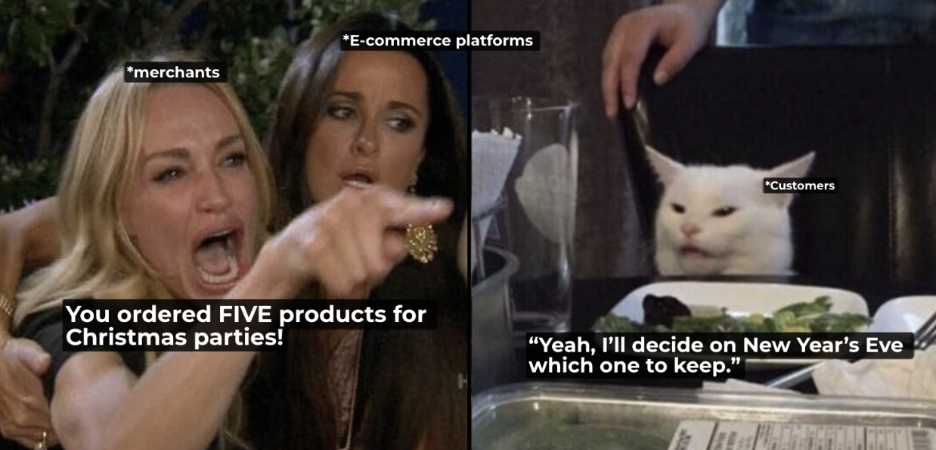

“Discount culture is scary. Especially with Prime Day and Black Friday. The reality? Most of those discounts aren’t even real.”
- Edmond Georges, Co- founder of Hobbiesville (a premier hobby and collectibles shop)
Every holiday season, consumers flock to their carts expecting miracles: 50% off, door-buster deals, flash sales.
But the reality is quite different. When we spoke with merchants running stores from $10 million to $40 million, they shared their perspective. And that contrast becomes even sharper when you look at the bigger picture.
E-commerce holiday sales are projected to reach between $305 billion and $310.7 billion in 2025, according to Deloitte’s annual holiday retail forecast, growing at a healthy pace of 7% to 9% year-over-year.
For shoppers, that feels like a win. For merchants, it’s often a margin trap - because what comes back can matter more than what goes out.
The average e-commerce return rate was 16.9% in 2024.
Why? Peak season discounts compress decision windows and encourage “buy now, decide later.” Add gifting, incorrect sizing, and impulse purchases, and January turns into “Returnuary.”
Loop Returns data shows that in the week after Christmas, return volumes rose 12.2% year over year.

One thing merchant have to ask: are these doorbuster deals really driving growth and profits, or just inflating sales and return volumes?
So, let’s look at real merchant experiences and how these challenges play out in practice and the steps they’re taking to fight back.
Within this return culture, one behavior has moved from the margins to the mainstream: bracketing. Ordering multiple sizes, colors, or models with the plan to return most isn’t just an occasional tactic anymore, it completely changed how a lot of customers think about shopping.
Surveys show that 39% of shoppers admit to bracketing and among Gen Z it’s more than half.
For younger consumers, “try at home” isn’t abuse; it’s just how online shopping works. Platforms have normalized frictionless returns, and with social media culture where trends flip overnight, bracketing doesn’t feel sneaky. It feels like a logical way to shop.
One Amazon seller vented on Reddit about how bracketing wipes out margins:
“Our sandals sell for $25. It costs us $9 to ship, leaving about $7 profit. When a customer orders two sizes, that’s $50 revenue but $18 shipping. She returns one pair; we eat another $6 in return fees and refund $25. Profit? Zero.
And even worse, when sometimes they return it damaged or missing the box, in some cases people buy size 7, 7.5 and 8 just to try them all.”
And it isn’t just small sellers. The story matches what we heard when we interviewed merchants operating stores ranging from $1 million to $40 million in annual sales. In those conversations, they pointed to the same dynamic.
Amazon’s customer-friendly policies have normalized “buy now, decide later.” That conditioning shows up both in the numbers and in merchant experiences.
As Harley Abrams, Director of sales and operations at SuperSpeed Golf 9 (a sports training company that sells swing-speed training aids and accessories), told us:
“On our site, returns are under one percent. On Amazon? Three to four percent. Sometimes even 10% if sizing gets messy.
To fight back, he restructured the product listing to reduce uncertainty before checkout:
The goal wasn’t to eliminate bracketing entirely, that’s unrealistic. But to lower the probability of misfit purchases.
Also increasingly, merchants are layering on AI-driven fit profiles and personalized size recommendations platforms to go a step further.
Think of how Amazon, Nike (Nike fit), or Shopify apps (True fit) now use past purchase data, body measurements, or even photos to predict the right size for each shopper.
These systems build a “fit profile” over time: if a customer has historically returned medium sizes but kept smalls, the algorithm nudges them toward small in future checkouts.
Others are tackling the problem through policy design. On Reddit, one apparel store owner shared how they tried to balance sales and returns by adjusting their policies.
"I own a retail store with about 15% of sales online. Earlier this fall, I tried charging for returns, but sales dipped, so I reverted back to free returns. "
He continued,
Still, I noticed heavy returns on certain brands and from customers ordering multiple sizes or event dresses. I dropped the worst-offending brands and stopped accepting multiple-size orders from the same customer. Before adjusting policies, my return rate was 17%. After, it dropped to 14%.”

That story highlights the balancing act: free returns boost visibility and conversion, but unchecked, they invite bracketing.
The solution isn’t one-size-fits-all. For some, it’s better product content. For others, it’s personalization tech. And for others still, it’s policy lines in the sand, refusing multiple-size orders, removing high-return SKUs, or putting guardrails around categories like event wear.
So, how are merchants tackling this, let’s take a look.
Not all returns are created equal, and neither are the defenses against them. In our merchant interviews, three distinct strategies emerged, each rooted in the nature of the product being sold.
When the products cost thousands of dollars, a single return can erase weeks of margin. That makes prevention, not processing, the core strategy.
Dan Carey, eCommerce Manager at Voltage Coffee Supply (specialty coffee equipment retailer), told us:
“The person is getting the right machine for their needs and their business, we put up a pretty hefty restocking fee in to try to avoid returns, but I think the best way that we avoid returns is that communication before the purchase.”
His point wasn’t about holiday shopping specifically, but it matters even more in Q4. One ill-informed $10,000 machine shipped in December can turn into a January return that wipes out the margin from multiple other orders.
That's why communication and restocking deterrents aren’t just good practice, they can be peak-season survival tactics.
This isn’t unique to coffee equipment. Luxury retailers from Rolex to Peloton employ the same principle: returns are too costly to absorb, so education and reassurance happen upfront.
Peloton, for instance, leans on in-home consultations and delivery specialists, ensuring customers understand space, setup, and usage before committing.
The higher the ticket size, the higher the need for human touch.

Some products are naturally resistant to returns, not because customers never regret their choices, but because the logistics make reversal nearly impossible.
Matt Daigle, CEO of Rise Home Design (a sustainable home improvement products store), explained:
“Luckily, that’s a great part of our business, we don’t really get any of those. It would be under 1%. So it’s negligible at best.”
Rise’s average order size is over $1,100 “A lot of them are installed as well, so it’s maybe hard to return them, right?” Daigle said.
“If you’re getting a water heater, unless it doesn’t work, you’d have to get a plumber to come take it out and then ship it back. It’s happened once or twice where it wasn’t sized properly, but in those cases, we just ship them the right model.”
That friction is a built-in defense.
Even during the holidays, 46% of their annual sales land in Q4, but their category is insulated: customers don’t impulse-buy water heaters on Black Friday. They research, commit, and once the product is in, it’s staying in.
By the time the unit is delivered, unboxed, and plumbed in, the thought of packing it back up for a return is practically off the table.
Most categories don’t have uninstall costs to protect them, but the principle still applies: design commitment into the customer journey so keeping the item feels easier than sending it back.
By letting customers “place” or “try” items virtually, these brands cut down mismatches and impulse purchases, making it more likely that once an item is bought, it stays bought.
For example, Dyson reduces returns by adding in-box QR codes linking to setup videos, helping customers troubleshoot at home instead of boxing up a return.
Warranties play a similar role, especially in electronics and appliances. By requiring registration or offering extended coverage at checkout, merchants create a natural point of commitment.
A shopper who feels protected is less likely to hedge with multiple purchases, and more willing to keep the product.
The holiday-season takeaway:
Whether through setup guidance, value-add perks, or better product education, merchants can borrow the same principle: reduce regret before it starts.
During the peak season, when order volumes spike and returns surge, making the purchase harder to reverse and easier to live with is one of the most reliable defenses.
Edmond Georges, Co-founder of Hobbiesville, a premier hobby and collectibles shop runs a trading card business where product value evaporates the moment a box is opened.
That reality shaped his entire returns strategy. “By default, we don’t really accept returns. We do, but we really don’t… We keep friction in the process on purpose.” he said.
Only sealed, unopened boxes are eligible. If a customer opens a pack and doesn’t like the cards inside, the resale value is already gone.
But returns aren’t the only risk.
In collectibles, peak season comes with another trap: discount culture. As Georges explained,
“If you go too hard on discounts, that first two weeks of December is like retail suicide.”
Black Friday brings a sales surge, but it’s often followed by a December slump as buyers wait for deeper markdowns/more discounts. The result is a demand “hangover” right when operating costs and return volumes peak.
To defend against that, Hobbiesville leans on value-add promotions instead of steep discounts.
For example, keeping a box at $200 but adding a protective case for free, or offering “buy more, get more” bundles. So, the sticker price holds, margins stay intact, and customers still feel they’re getting more for their money.
David Schwartz, Director of eCommerce at MedMassager, saw how much the return process itself shapes outcomes.
He implemented ReturnLogic (end-to-end returns management platform for e-commerce brands) to automate the flow across both retail and B2B storefronts and returns went up.
“I made the return process a lot easier for customers and for staff, which kind of increased the amount of returns because it wasn’t as much of a pain point anymore,”
With more structured data, the biggest issue became clear: quality concerns, which wasn’t the case before.
His defense was to press the factory harder, demand accountability, and require customers to leave detailed comments with each return. That allowed him to start mapping problems back to serial numbers and batches.
His next move? Packaging.
“If you can improve the unboxing experience, that reduces the pain of an expensive purchase and that might help lower the return rate.”
In peak season, this feedback loop becomes survival.
Easier returns mean more volume comes back in January, but they also give merchants the data to prevent the next wave. For Schwartz, the defense isn’t avoiding returns, but using them as intelligence: automation for visibility, feedback for supplier leverage, and packaging design as a preemptive shield.
The dark side of peak season isn’t only about customer behavior. Bracketing, discount-chasing, and impulse gifting are real, but so are the challenges on the merchant side from unclear sizing and rushed communication to packaging and quality gaps.
Sometimes a return is rational, a few times it’s abusive, and sometimes it’s the result of mismatched expectations.
That’s why peak season isn’t just a sales sprint. It’s a stress test of the entire chain; product integrity, policy design, platform incentives, and customer trust.
So, the question merchants should really be asking isn’t “How do we stop returns?”
It’s “When returns happen, how do we handle that to our advantage?”